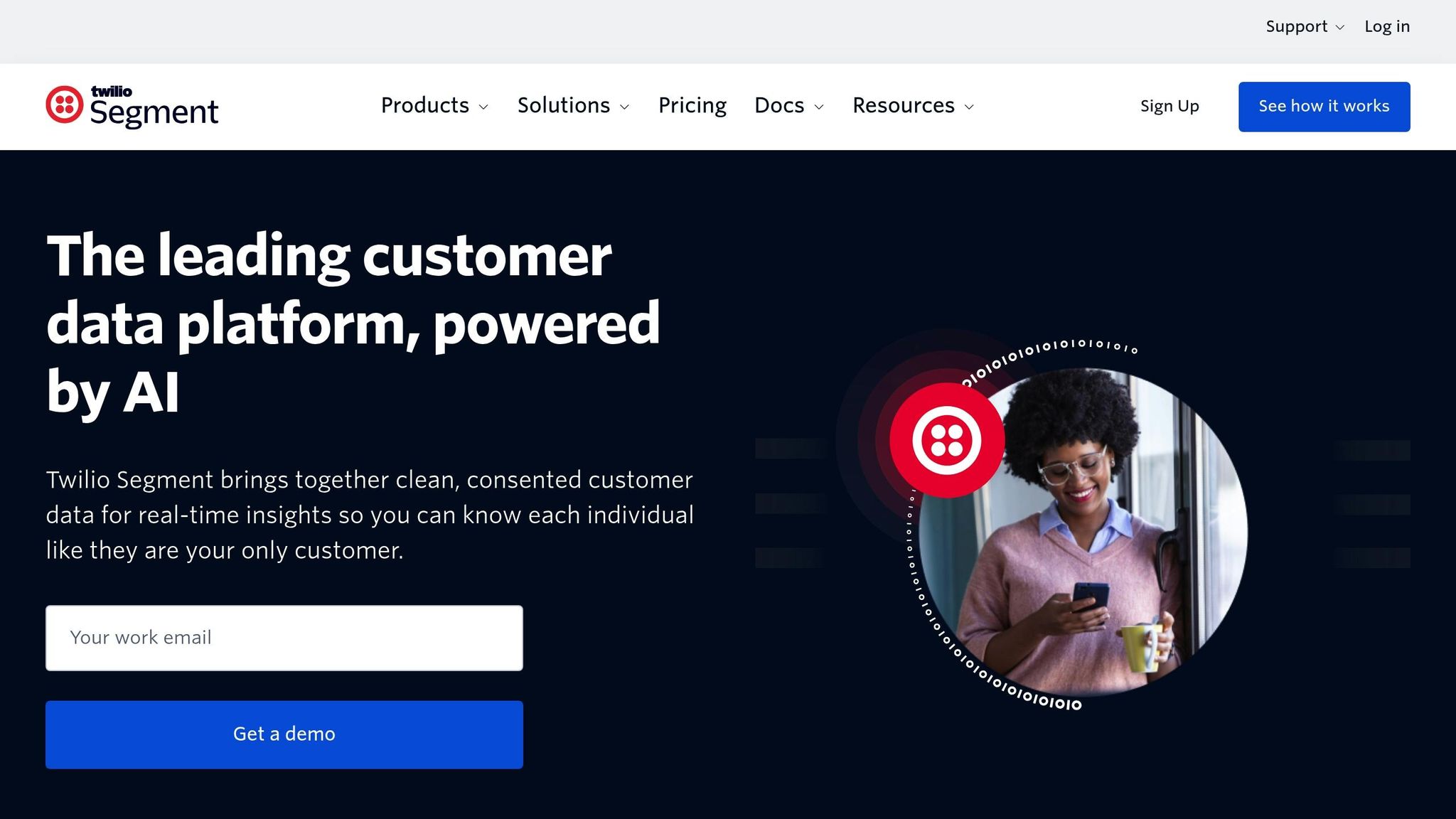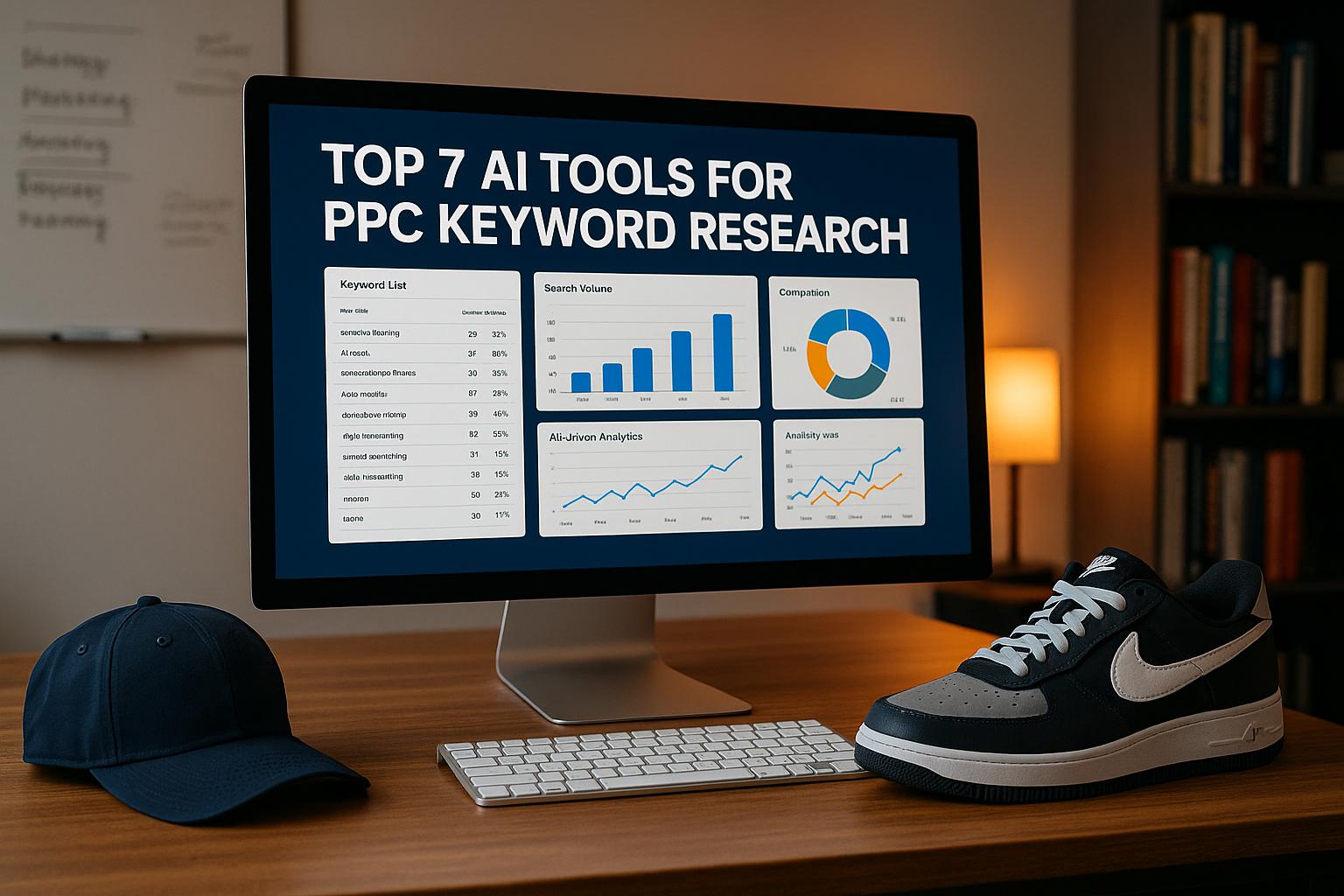AI-powered segmentation is transforming e-commerce email marketing by using advanced algorithms to create highly targeted customer groups. Instead of relying on basic demographics, AI analyzes both structured (purchase history) and unstructured data (social media activity, text) to predict customer behavior and deliver personalized campaigns. This approach leads to:
- Better Engagement: 22% higher open rates and 32% more click-throughs.
- Higher Revenue: Up to 760% more revenue from segmented emails.
- Improved Efficiency: Automation reduces manual tasks and adapts in real-time.
- Accurate Targeting: Micro-segmentation boosts conversion rates by 15%.
AI tools like Klaviyo, ActiveCampaign, and Mailchimp simplify segmentation, offering features like predictive analytics and behavior-based triggers. To succeed, businesses must prepare clean, centralized data, implement automated workflows, and stay privacy-compliant. Metrics such as open rates, click-through rates, and revenue per recipient help measure success. With AI, email marketing becomes smarter, faster, and more effective.
8 Best Ways To Segment Your Email List (Klaviyo-friendly Tutorial)

Main AI Segmentation Strategies
AI is reshaping e-commerce email marketing with three key segmentation strategies. Each approach offers a unique way to create highly targeted campaigns that align with changing customer behaviors.
Behavioral Segmentation
Behavioral segmentation relies on AI to analyze customer interactions – like browsing habits, purchase history, email responses, and social media activity – to create dynamic, real-time profiles. This approach helps uncover patterns that might otherwise go unnoticed. Rui Nunes, founder of SendXmail, Zopply, and HotLeads, highlights its potential:
"Some of our best-performing and overlooked segments are based on past behaviors in our web properties and campaigns. Marketers rely mostly on permanent data like age and sources, while behavioral data is often more accurate and less biased."
Take Hotel Chocolat, for example. By segmenting customers based on how they signed up and their ongoing interactions, the company saw a 20% revenue boost from email, a 12% increase in total website revenue, and a 22% jump in average order value. Similarly, SwayChic used historical behavior data to refine email targeting, achieving a 40% rise in open rates, double the click-through rates, and triple the revenue per campaign.
What sets AI apart is its ability to continuously monitor customer actions and update segments automatically, ensuring campaigns stay relevant. But while behavioral segmentation focuses on what customers have done, predictive segmentation takes it a step further by forecasting what they’ll do next.
Predictive Segmentation
Predictive segmentation uses machine learning to anticipate customer behaviors, enabling marketers to deliver timely and relevant content. Instead of reacting to past actions, this method predicts trends like repeat purchases, churn risks, and upselling opportunities.
American Express is a prime example of how predictive segmentation can outperform traditional methods. By grouping customers based on spending habits and financial needs, they identified high-value microsegments, resulting in 2.5 times higher engagement per impression and double the campaign performance compared to standard audience targeting.
PUMA also tapped into predictive segmentation with SAP Emarsys, targeting high-potential buyers based on engagement patterns and leveraging AI for send-time optimization. This led to triple-digit year-over-year growth in email-driven revenue, a 5–10% lift in open rates, and a fivefold increase in email revenue within a year.
While predictive segmentation focuses on future actions, AI-enhanced RFM analysis brings a fresh perspective to a classic marketing tool.
RFM Analysis with AI
RFM analysis – short for Recency, Frequency, and Monetary value – has been a go-to method for identifying valuable customer segments. AI takes this traditional approach to the next level by automating calculations and uncovering patterns that manual methods might miss. It can incorporate more variables and identify subtle trends, such as customers at risk of churning or emerging high-value groups.
This strategy is particularly effective for larger e-commerce businesses, where a small group of repeat customers can account for up to 40% of total revenue. AI-driven RFM analysis helps businesses pinpoint and nurture these high-value customers for maximum impact.
L’Oréal showcases the power of combining RFM principles with real-time behavioral data. By analyzing preferences, browsing habits, and purchase patterns, their AI tools deliver personalized product recommendations, achieving a 22.22% conversion rate and a 26.25% increase in click-through rates.
AI also enables dynamic RFM scoring, which updates instantly as customer behavior evolves. This ensures that high-value segments receive the right level of engagement while at-risk customers get targeted re-engagement efforts. As Jeffrey Goldsmith, Fractional CMO, puts it:
"Behaviors that generate high scores – site visits, email opens, content downloads, forward detection, email clicks – are reliable proof that specific customers should be targeted for follow-up."
Together, these three AI-driven strategies – behavioral segmentation, predictive segmentation, and RFM analysis – offer a powerful toolkit for crafting email campaigns that not only reflect customer behavior but also anticipate their needs and adapt in real time.
AI Tools for E-commerce Email Segmentation
AI tools have reshaped email marketing, turning generic email blasts into tailored campaigns. Did you know that 41% of small businesses already use AI for email marketing? Even better, AI-powered emails boast a 32% higher open rate compared to standard business emails. With such results, choosing the right platform has become essential for staying ahead in the competitive e-commerce landscape.
Popular AI Tools Overview
Klaviyo is a standout for e-commerce businesses, thanks to its seamless integration with Shopify and WooCommerce. Its AI engine dynamically segments customers in real time, offering predictive analytics that pinpoints customers likely to make repeat purchases or those at risk of leaving. It also uses machine learning to optimize send times, ensuring emails land in inboxes at the perfect moment.
ActiveCampaign is ideal for businesses managing complex workflows. Its AI features include predictive sending, which analyzes engagement patterns to determine the best delivery times, and machine learning-powered content recommendations. Additionally, its behavioral triggers guide customers through intricate nurture sequences based on their actions across various touchpoints.
Mailchimp provides a user-friendly solution with its Customer Journey Builder. This AI tool maps out the best customer paths for different audience segments. Its predictive demographics feature fills in missing customer data, while its product recommendation engine inserts relevant products into emails based on browsing and purchase history.
Encharge caters to SaaS and product-led companies with its behavior-based email automation. It tracks user actions within applications to trigger personalized email sequences. Its machine learning algorithms fine-tune send times and identify the most effective content for different user segments.
Brevo (formerly Sendinblue) is a budget-friendly option for multichannel marketing, offering email, SMS, and chat features. Its AI tools include smart segmentation based on engagement patterns and automated A/B testing to refine campaign performance continuously.
Each of these platforms leverages customer data to enhance segmentation, content, and timing, ensuring consistent optimization. The table below provides a quick comparison of their features and strengths.
AI Tools Comparison
| Tool | Best For | Key AI Features | Integration Capabilities | Standout Benefit |
|---|---|---|---|---|
| Klaviyo | E-commerce businesses | Predictive analytics, dynamic segmentation, send-time optimization | Shopify, WooCommerce, Magento, BigCommerce | Deep integration with e-commerce platforms |
| ActiveCampaign | Advanced automation needs | Predictive sending, behavioral triggers, machine learning content recommendations | Shopify, Stripe, HubSpot, Zapier | Sophisticated workflow management |
| Mailchimp | Small to medium businesses | Customer Journey Builder, predictive demographics, product recommendations | Shopify, WooCommerce, Salesforce, Google Analytics | Easy-to-use AI features |
| Encharge | SaaS and product-led companies | Behavior-based automation, user action tracking, send-time optimization | Segment, Mixpanel, Amplitude, Stripe | Tracks application behavior |
| Brevo | Budget-conscious marketers | Smart segmentation, automated A/B testing, engagement optimization | Shopify, WooCommerce, Salesforce, WordPress | Affordable multichannel marketing |
When deciding on a tool, consider your team’s technical skills and how well the platform integrates with your existing marketing stack. Chris Wlezien, founder and product innovation strategist at Eureka Partners, emphasizes:
"All ecommerce businesses can benefit from integrating AI in a variety of ways, from improving the efficiency of daily tasks with LLMs (large language models) or other specific tools, to improved and personalized product recommendations, or creating content and copy for marketing collateral."
The best way to find the right fit? Take advantage of free trials to test each platform’s AI features and see how they align with your business needs. Look for tools that integrate smoothly with your CRM and e-commerce systems to avoid manual syncing headaches. With AI tools typically priced between $29 and $85 per month, they’re an affordable way to boost engagement and drive conversions.
sbb-itb-d6d4d8b
How to Implement AI-Driven Segmentation
Leveraging AI tools for segmentation starts with solid data management and a well-planned execution strategy. The success of AI-driven segmentation hinges on preparing your data properly and establishing efficient workflows.
Data Preparation and Management
Data preparation lays the groundwork for effective segmentation. Start by gathering data from all customer touchpoints using techniques like progressive profiling. This allows you to collect essential demographic, behavioral, and transactional details gradually. For instance, keep sign-up forms simple by asking for basic information like an email address. Over time, you can gather more data through surveys, preference centers, or post-purchase feedback forms. Focus on collecting only what you need – if age isn’t relevant to your campaigns, skip requesting birthdates.
Keep your data clean and up-to-date. Regularly remove duplicates, update outdated information, and fill in missing fields. This step can significantly improve your segmentation quality. As Thamima Christensen, Head of Product for Oracle Eloqua Marketing Automation, puts it:
"Many brands collect vast amounts of customer data, but without a centralized data strategy and real-time activation, that data often sits unused. Integrating AI-driven segmentation and automation can bridge that gap and turn data into meaningful customer interactions."
A centralized customer database is key. Combine data from your e-commerce platform, email system, customer service tools, and social media channels into one unified view. This approach enables AI algorithms to uncover patterns and insights that isolated datasets often miss.
Setting Up Automated Segmentation Workflows
Once your data is in order, you can create automated workflows that keep customer segments updated in real time. Train your AI with data specific to your business, and set triggers based on behaviors like cart abandonment or page visits. This helps the system learn what success looks like for your brand.
Dynamic product recommendations are a standout use case for automated segmentation. Your AI can generate personalized product suggestions in emails by analyzing each customer’s browsing and purchase history.
Rafael Viana, Senior Email Marketing Strategist at Validity, explains the value of AI in managing campaigns:
"As an email marketer, you’re already doing so much that, for many of us, adding AI feels like one more thing to make you overwhelmed. With AI, I think the idea is not to use it so you can create more new campaigns every day, but so you can manage more personalized, dynamic, or detailed email campaigns that perform better."
Introduce AI capabilities gradually. Start with features like send-time optimization, then expand based on measurable results. This phased approach makes it easier to troubleshoot and refine your workflows.
Additionally, ensure your AI adjusts its messaging tone and content based on the audience. For example, it could adopt a formal tone for B2B customers while keeping things casual for younger audiences. Tailor the content based on prior engagement patterns to improve relevance. As you automate workflows, prioritize privacy protocols to maintain customer trust.
Data Privacy Compliance
Compliance with data privacy regulations is non-negotiable. In the U.S., this means adhering to laws like the California Consumer Privacy Act (CCPA) and other state-level rules.
Obtaining explicit consent is a cornerstone of compliance. While the CCPA uses an opt-out model for data sales, clear consent for data collection and processing is still critical. Your privacy notices should clearly explain how customer data will be used for AI-driven personalization.
Collect only the data you need. For example, if precise location data isn’t essential for your segmentation, avoid gathering it. This not only reduces compliance risks but also builds customer trust.
Your systems should also allow customers to easily access, correct, or delete their information. Automated workflows must promptly remove data upon request.
Given the large volumes of personal data processed by AI, security is paramount. Use encryption for both storage and transmission, enforce strict access controls, and regularly audit your systems for vulnerabilities. Where possible, anonymize data to detect patterns without handling identifiable information.
Finally, keep compliance efforts ongoing by conducting regular audits and documenting your AI’s decision-making processes. This proactive approach not only keeps you aligned with evolving regulations but also reinforces customer confidence in your brand.
With a strong foundation of accurate, compliant data, the next step is to measure the performance of your segmentation efforts effectively.
Measuring and Improving AI Segmentation Results
Once you’ve implemented AI segmentation, the next step is to measure its effectiveness. Tracking performance metrics not only helps validate its success but also highlights areas for improvement. By analyzing these results, you can refine your segmentation strategies and drive better outcomes.
Key Metrics to Track
Start by keeping an eye on core engagement metrics. These include open rates (the industry average is 21.33%), click-through rates (CTR typically ranges from 2% to 5%), and conversion rates, which measure how many recipients complete a desired action, like making a purchase.
For a more direct look at how AI segmentation impacts revenue, focus on metrics like revenue per recipient (RPR). As Randy McHugh, Founder of Stimulate Agency, advises:
"The best way to optimize email revenue per recipient is by refining your segmentation strategy."
Research shows that email marketing should account for 25% to 35% of an e-commerce business’s revenue, with top performers trending between 35% and 45%. Another key metric to track is customer lifetime value (CLTV), which reflects the long-term financial benefits of targeted segmentation.
It’s also essential to monitor list health metrics. Bounce rates (ideally around 0.5%) and unsubscribe rates (approximately 0.25%) can signal whether your segmentation strategy is too aggressive or poorly targeted. Additionally, look beyond basic metrics to assess engagement depth – such as time spent on your site and the number of pages viewed after clicking through an email.
Continuous Improvement with AI
AI doesn’t just segment your audience – it learns and adapts over time. By analyzing real-time customer interactions, AI identifies which segments respond best to specific content, timing, and offers. This dynamic approach allows marketers to predict future behaviors and fine-tune campaigns accordingly.
For example, one marketer reported a tenfold improvement in A/B testing performance after incorporating generative AI into their email strategy. The AI optimized not only subject lines but also audience targeting based on user behavior patterns. Pilot campaigns can be a great way to test AI segmentation on smaller groups before scaling up. One e-commerce retailer using AI for personalized product recommendations saw a 25% increase in click-through rates and a 15% boost in conversion rates. Similarly, a travel agency leveraging AI-driven segmentation based on recent search behaviors achieved a 30% improvement in booking rates from email campaigns.
To maintain effectiveness, regularly review and adjust your AI systems as new data becomes available. Incorporating subscriber feedback through surveys and preference centers can also help refine your AI’s understanding of customer preferences.
Performance Comparison: Before and After AI
To truly understand the impact of AI segmentation, compare your results before and after implementation. Here’s a snapshot of how AI can enhance key metrics:
| Metric | Before AI Segmentation | After AI Segmentation | Improvement |
|---|---|---|---|
| Open Rate | 18.5% | 24.2% | +31% |
| Click-Through Rate | 2.8% | 4.3% | +54% |
| Conversion Rate | 1.2% | 1.5% | +25% |
| Revenue per Recipient | $0.85 | $3.40 | +300% |
| Unsubscribe Rate | 0.4% | 0.2% | -50% |
Beyond these metrics, consider how AI segmentation affects broader customer behaviors, such as purchase frequency and average order value. Over time, AI-driven segments often outperform traditional demographic-based approaches in fostering long-term retention.
Track performance over time to gauge how AI segmentation evolves. Many businesses notice initial improvements within the first month, with more significant gains emerging over three to six months as the AI learns from ongoing customer interactions.
Consistent analysis and refinement will ensure your AI segmentation strategy stays effective, helping you uncover new opportunities to improve and grow.
Conclusion: Getting Started with AI Email Segmentation
AI-driven segmentation is reshaping email marketing by customizing campaigns based on customer behaviors. The numbers speak for themselves: segmented email campaigns can increase revenue by up to 760% and achieve conversion rates six times higher than generic emails. With nearly 89% of marketers predicting that most email workflows will rely on AI by the end of 2026, there’s no better time to dive in.
You don’t need to overhaul your entire system to get started. Begin with simple, no-code AI tools like send-time optimization, content selection, and subject line testing. These tools are beginner-friendly but still deliver measurable improvements. As you gain confidence, you can explore more advanced options like real-time personalization and behavioral segmentation.
A strong start requires a solid data foundation. Collect detailed information about your subscribers, including demographics, purchase history, and engagement patterns. This data allows AI tools to create precise audience segments that drive results. Clearly define your campaign goals upfront – this will help you choose the right tools and focus on metrics that matter.
Real-world examples underline the effectiveness of AI-driven email personalization. For instance, Hydrant achieved a 260% increase in conversions with AI-powered retention campaigns. eBay saw open rates rise by 15.8% and click-through rates jump by 31.2% thanks to AI-generated subject lines. Even fashion brands have reported a 35% boost in sales by using AI to identify style preferences and tailor their campaigns.
The best part? AI is accessible, even for beginners. Nearly half of marketers using AI are new to the technology, and 95% of them find generative AI effective for creating email content. To ensure success, focus on ethical practices: maintain transparency, respect privacy regulations, and set clear, achievable goals for your AI initiatives.
Start small, experiment consistently, and let the data guide your decisions. With potential revenue gains of up to 320%, integrating AI segmentation into your email strategy is a smart move for any modern e-commerce business.
FAQs
How can AI-powered segmentation make e-commerce email marketing more effective than traditional methods?
AI-driven segmentation is reshaping e-commerce email marketing by processing massive amounts of data in real time to identify customer behaviors and preferences. This approach enables businesses to craft emails that feel personal and relevant, connecting more effectively with their audience.
Traditional segmentation methods often rely on static or generalized categories, but AI takes it a step further by adapting to customer actions as they happen. The result? Emails that are perfectly timed and tailored, leading to better engagement, higher open rates, and more conversions. It’s a smarter, more efficient way to make your marketing efforts count.
How can I ensure data privacy compliance when using AI for email segmentation?
To stay aligned with data privacy regulations, it’s crucial to take a few key steps. First, focus on anonymizing or pseudonymizing customer data to shield personal identities. Implement secure storage and encryption techniques to keep sensitive information safe. Always make sure to get explicit consent from users before collecting or processing their data, and ensure your methods comply with laws such as the GDPR and CCPA. Lastly, prioritize transparency by clearly explaining how customer data is gathered, stored, and used in your email campaigns. These practices not only help meet legal requirements but also foster trust with your audience.
What metrics should businesses track to evaluate the success of AI-driven email segmentation?
To gauge how well AI-driven email segmentation is working, businesses should keep an eye on specific key performance indicators (KPIs) that showcase how effective their campaigns are and how engaged their audience is. Some of the most important metrics to track include:
- Open rates: This tells you how many recipients are actually opening your emails.
- Click-through rates (CTR): See how many people are clicking on the links within your emails.
- Conversion rates: Measure how many recipients take the desired action – whether that’s making a purchase, signing up, or something else.
- Revenue generated: Calculate the total income directly tied to your segmented email campaigns.
- ROI (Return on Investment): Determine whether your campaigns are delivering enough value to justify the costs.
Beyond these metrics, keeping an eye on customer satisfaction and how engaged your audience feels can provide valuable insights. This feedback can help you fine-tune your segmentation efforts and create even more tailored, impactful experiences.








